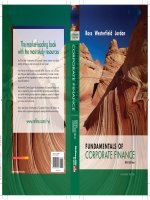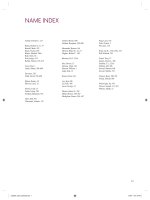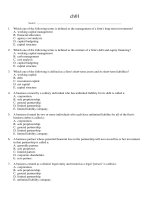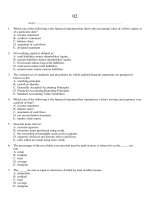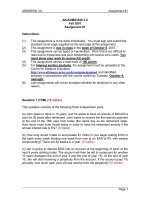assignment10 fundamentals of corporate finance, 4th edition brealey
Bạn đang xem bản rút gọn của tài liệu. Xem và tải ngay bản đầy đủ của tài liệu tại đây (220.19 KB, 17 trang )
ADMS3530 3.0
Assignment #2
AK/ADMS3530
Summer 2007
Assignment #2 -SOLUTIONS
Instructions:
(1)
This assignment is to be done individually. You must sign and submit the
standard cover page supplied as the last page of this assignment.
(2)
This assignment is due at the start of class, the week of July 23rd, 2007
(last class). This assignment can be typewritten or handwritten. Work
that is too difficult to read due to messiness and poor handwriting will
receive zero credit. You must show your work to receive full credit.
(3)
This assignment is worth a total of 100 marks and represents 10% of your
overall grade.
Page 1
ADMS3530 3.0
Assignment #2
Question #1 (14 marks)
(a) (5 marks)
A capital investment requiring one initial cash outflow is forecast to operating
profits (cash) as follows
Year 1
Year 2
Year 3
Year 4
$74,000
$84,000
$96,000
$70,000
The investment has an NPV of $20,850 based on a required rate of return of
12%. Calculate the payback period of the investment.
Solution
(a)Since the investment's NPV is $20,850, the initial investment is the value of Inv
satisfying
$20,850 =
$74,000
$84,000
$96,000
$70,000
+
+
+
– Inv
2
3
1.12
1.12
1.12
1.12 4
= $66,071.4 + $66,964.3 + $68,330.9 + $44,486.3 – Inv
Inv = $225,003
Full payback on the project occurs sometime between years 2 and 3 to recover our
initial investment of $225,003.
Cumulative profit after 2 years = $74,000 + $84,000 = $158,000
Cumulative profit after 3 years = $158,000 + 96,000 = $254,000
Payback period = 2 +
$225,003 − $158,000
= 2.7 yrs or 2 yrs 8 months
$254,000 − $158,000
Page 2
ADMS3530 3.0
Assignment #2
(b) (9 marks)
The initial investment and expected profits (cash) from 2 mutually exclusive
capital investments being considered by a firm are as follows:
Investment A
Investment B
Initial Investment
70,000
65,000
Year 1 profit
30,000
50,000
Year 2 profit
80,000
50,000
Calculate the internal rate of return for each investment. Which one would be
selected based on an IRR ranking? (3 marks).
(i)
Which investment should be chosen if the firm’s cost of capital is 14%
(support your answer)? (3 marks).
(ii)
Which investment should be chosen if the firm’s cost of capital is 17%
(support your answer)? (3 marks).
Solution (b)
(i) The IRR on Investment A is the value of i satisfying
NPV = 0 =
$30,000
$80,000
+
– $70,000
1+ i
(1 + i )2
The solution is i = 30.5% = IRR on Investment A.
The IRR on Investment B is the value of i satisfying
NPV = 0 =
$50,000
$50,000
+
– $65,000
1+ i
(1 + i )2
The solution is i = 34.2% = IRR on Investment B.
Investment B would be selected on the basis on an IRR ranking.
(ii)
$80,000
$30,000
+
– $70,000 = $17,873
1.14
1.14 2
$50,000
$50,000
+
– $65,000 = $17,333
NPV(Investment B) =
1.14
1.14 2
NPV(Investment A) =
With the cost of capital at 14%, Investment A has the larger NPV and
should be chosen.
(iii) Similarly, if you repeat part (ii) with the cost of capital of 17%, you would derive
the following answers.
NPV(Investment A) = $14,082
NPV(Investment B) = $14,261
Investment B now has the higher NPV and should be chosen.
Page 3
ADMS3530 3.0
Assignment #2
Question #2 (14 marks)
Allergy-free Corp. is considering launching a “hay-fever” vaccine in Canada that
will eliminate entirely the need for many Canadians to take seasonal allergy
medication. The vaccines will be sold to the medical community and government
for $2.30 per vaccine. Variable costs are $0.6440 per pill and fixed costs
excluding depreciation are $3,500,000 per year. The capital investment for the
new manufacturing equipment will be $4,500,000 and will be depreciated
straight-line over 8 years to a final value of zero. Allergy-free Corp.’s cost of
capital is 14% annually and it currently pays no taxes.
(a) What is the accounting break-even level of sales for the new vaccine, in
terms of number of vaccines that must be sold?
Solution
Variable cost = $0.644 / $2.30 = $0.28 per $1 of revenue
Additional profit per $1 of additional sales is therefore $0.72
Depreciation per year = $4,500,000 / 8 = $562,500 f��������������������������������������������������������������������������������������������������������������������������������������������������������������������������������������������������������������������������������������������������������������������������������������������������������������������������������������������������������������������������������������������������������������������������������������������������������������������������������������������������������������������������������������������������������������������������������������������������������������������������������������������������������������������������������������������������������������������������������������������������������������������������������������������������������������������������������������������������������������������������������������������������������������������������������������������������������������������������������������������������������������������������������������������������������������������������������������������������������������������������������������������������������������������������������������������������������������������������������������������������������������������������������������������������������������������������������������������������������������������������������������������������������������������������������������������������������������������������������������������������������������������������������������������������������������������������������������������������������������������������������������������������������������������������������������������������������������������������������������������������������������������������������������������������������������������������������������������������������������������������������������������������������������������������������������������������������������������������������������������������������������������������������������������������������������������������������������������������������������������������������������������������������������������������������������������������������������������������������������������������������������������������������������������������������������������������������������������������������������������������������������������������������������������������������������������������������������������������������������������������������������������������������������������������������������������������������������������������������������������������������������������������������������������������������������������������������������������������������������������������������������������������������������������������������������������������������������������������������������������������������������������������������������������������������������������������������������������������������������������������������������������������������������������������������������������������������������������������������������������������������������������������������������������������������������������������������������������������������������������������������������������������������������������������������������������������������������������������������������������������������������������������������������������������������������������������������������������������������������������������������������������������������������������������������������������������������������������������������������������������������������������������������������������������������������������������������������������������������������������������������������������������������������������������������������������������������������������������������������������������������������������������������������������������������������������������������������������������������������������������������������������������������������������������������������������������������������������������������������������������������������������������������������������������������������������������������������������������������������������������������������������������������������������������������������������������������������������������������������������������������������������������������������������������������������������������������������������������������������������������������������������������������������������������������������������������������������������������������������������������������������������������������������������������������������������������������������������������������������������������������������������������������������������������������������������������������������������������������������������������������������������������������������������������������������������������������������������������������������������������������������������������������������������������������������������������������������������������������������������������������������������������������������������������������������������������������������������������������������������������������������������������������������������������������������������������������������������������������������������������������������������������������������������������������������������������������������������������������������������������������������������������������������������������������������������������������������������������������������������������������������������������������������������������������������������������������������������������������������������������������������������������������������������������������������������������������������������������������������������������������������������������������������������������������������������������������������������������������������������������������������������������������������������������������������������������������������������������������������������������������������������������������������������������������������������������������������������������������������������������������������������������������������������������������������������������������������������������������������������������������������������������������������������������������������������������������������������������������������������������������������������������������������������������������������������������������������������������������������������������������������������������������������������������������������������������������������������������������������������������������������������������������������������������������������������������������������������������������������������������������������������������������������������������������������������������������������������������������������������������������������������������������������������������������������������������������������������������������������������������������������������������������������������������������������������������������������������������������������������������������������������������������������������������������������������������������������������������������������������������������������������������������������������������������������������������������������������������������������������������������������������������������������������������������������������������������������������������������������������������������������������������������������������������������������������������������������������������������������������������������������������������������������������������������������������������������������������������������������������������������������������������������������������������������������������������������������������������������������������������������������������������������������������������������������������������������������������������������������������������������������������������������������������������������������������������������������������������������������������������������������������������������������������������������������������������������������������������������������������������������������������������������������������������������������������������������������������������������������������������������������������������������ares of common stocks outstanding, which just paid $0.75 dividend per share.
The firm’s common stocks have a beta of 1.5. The annual sustainable growth
rate of the firm’s earnings and dividends is 3%. The risk-free rate is 3.5% and the
rate of return on the market portfolio is 12%. The firm pays taxes at a rate of
35%. Compute Cocoa’s WACC.
Solution
Bonds:
The market price of bond today is:
1
1
Face Value
−
]+
PB = C × [
t
rdebt rdebt (1 + rdebt )
(1 + rdebt ) t
1
1
$1,000
−
]+
30
0.03 0.03(1 + 0.03)
(1 + 0.03) 30
= $1,098.
The number of bonds issued = $45,000,000/$1,000 = 45,000.
So the total market value of bonds is: D = 45,000 × $1,098 = $49,410,099.30
= $35 × [
Preferred stocks:
The par value of each preferred stock = $7,500,000/250,000 = $30.
The annual dividend paid on each preferred stock = $30 × 4.5% = $1.35.
So the market price of preferred stock per share = $1.35/0.05 = $27, and the total
market value of preferred stocks is: P = 250,000 × $27 = $6,750,000.
Common stocks:
Using the CAPM, we can calculate the cost of common stocks as:
requity = r f + β (rm − r f ) = 3.5% + 1.5 × (12% − 3.5%) = 16.25%.
Using the DDM, we can compute today’s common stock price as:
DIV1
$0.75 × (1 + 3%)
P0 =
=
= $5.83.
requity − g
16.25% − 3%
Therefore, the total market value of common stocks is:
E = 3,000,000 × $5.83 = $17,490,566.04
Page 12
ADMS3530 3.0
Assignment #2
Cocoa Corp.’s total market value is:
V = D + P +E = $(49,410,099.30 + 6,750,000 + 17,490,566.04)
= $73,650,665.34
The weights of each security are: D/V = 0.6709, P/V = 0.0916, and E/V = 0.2375.
D
P
E
× (1 − Tc )rdebt ] + [ × rpreferred ] + [ × requity ]
V
V
V
= [0.6709 × (1 − 0.35) × 0.06] + [0.0916 × 0.05] + [0.2375 × 0.1625]
WACC = [
= 0.0693.
So Cocoa Corp.’s WACC is about 6.93%.
Page 13
ADMS3530 3.0
Assignment #2
Question #7 (20 marks)
To compete with Apple’s new i-Phone, Motorola is planning on unveiling its Mphone, a smart phone that include voice, internet access, unlimited data and a
new feature that allows users to scroll through their voicemail in an inbox like
email.
The Motorola marketing department estimates annual sales of 150,000, 250,000,
80,000 and 30,000 units for years one to four respectively and which time, the
life cycle will end. Pricing will be aggressive. Motorola will sell the M-phone at a
price of $490 in the first year and then reduce it by $70 a year to appeal to the
mass markets. Fixed costs are $3.2 million annually and variable costs are
estimated at 35% of the selling price. In addition, the Motorola accounting
department will allocate general overhead of $2 million annually.
The manufacturing equipment will cost $30 million, $4 million to
transport and another $1 million to install and falls into the class 8 (CCA
rate = 20%) pool along with other equipment. After Year 4 there will still be class
8 assets remaining in the pool and the half-year rule applies. At the end of the
project, the equipment can be sold as salvage for $75,000. Initial net working
capital (NWC) investment is forecast to be $1.5 million (today) and is expected to
decrease by $200,000 in each year from year 1 to year 4. It is estimated that
there will be a complete recovery of net working capital in year 5.
R&D for this machine has been steep costing $20 million over the past two years
and expected additional $5 million in R&D is expected to be incurred in year one
before launching the multi-language version outside of the USA. The M-phone
will be manufactured in China in a manufacturing plant already owned by
Motorola and currently vacant. The plant cost $4.0 million two years ago and has
a current market value of $12.5 million. Unfortunately, as consumers buy the Mphone, Motorola expects profits of existing products, will be reduced by $2.5
million annually during the M-phone product life cycle. Motorola pays corporate
taxes at the marginal rate of 36% and the CFO requires that all projects
worldwide earn at least 7% above its weighted average cost of capital.
In addition you are given the following financial information:
Motorola Balance Sheet ( Book Value in $millions)
Assets
Cash & short-term securities
Accounts receivable
Inventories
Plant & Equipment
Total Assets
$10
30
70
110
$220
Liabilities & Net Worth
Bonds 8% coupon (paid semi-annually),
Maturity = 10 years, current YTM = 9%
Preferred Stock (par value = $20/share)
Common Stock
Retained Earnings
Total liabilities & net worth
Page 14
$40
20
50
110
$220
ADMS3530 3.0
Assignment #2
Other Info:
• Preferred stock currently sells for $15/share
• Common stock sells for $20/share
• There are 3 million common shares outstanding
• Preferred stock pays a $2 dividend per share
• Beta of common stock is 0.8
• Market risk premium is 10%
• Risk-free rate is 6%
Should Motorola go ahead with the M-phone project?
Solution:
Break the problem down into 2 parts: Part A and Part B
Part A: Find Motorola’s WACC:
WACC Step#1: Find market value of each of the firm’s securities:
(i) Bonds (Debt)
The bonds must be selling below par value, because the YTM is greater than the
coupon rate.
The price (per $1000 par value) = PV (coupons) + PV (face value)
Using your calculator:
FV = $1000, PMT = $80/2=40, i = 9/2=4.5%, n = 20, COMP PV
PV = -$934.96
The total market value of the bonds is
$40 million par value × $935.96 market value per bond
$1,000 par value per bond
= $37,478,400 million
(ii) Preferred Stock:
There are $20 book value million/$20 book(par) value per share = 1,000,000
shares of preferred stock selling at $15 per share,
for total market value of $15,000,000 million.
(iii) Common Stock
There are 3 million shares of common stock selling at $20/share, for a total market
value $60 million.
WACC Step 2: Calculate proportion of firm’s total market value (V) that each
security contributes:
Page 15
ADMS3530 3.0
Assignment #2
The capital structure is:
Dollars
Bonds
Preferred Stock
Common Stock
Total
37.4784 million
15.0 million
60.00 million
112.4784 million
Percent
33.21%
13.34%
53.35%
100.0%
Step 3: Determine the required rate of return on each security
(i) The yield to maturity on debt is rdebt = 9%
(ii) The rate on preferred stock is rpreferred = $2/$15 = .133 = 13.3%
(iii) The rate on common stock is
requity = rf + β(rm – rf) = 6% + .8 × 10% = 14%
Step 4: Calculate the weighted-average of these returns:
Using the capital structure derived in the previous problem, we can calculate WACC as:
WACC = Error!× rdebt + Error!× requity + Error! × rpreferred
= .3321 × (1 – .36) × 9% + .5335 × 14% + .1334 × 13.3%
= .01913 + .07469 + .01744
= .1116
= 11.16%
Part B: Find Motorola’s discount rate
= 7% + WACC = 7% + 11.16% = 18.16% use this rate to discount project’s
cash flows to find project NPV
Æ see spreadsheet below for details
NPV Motorola Project = 11,487,272
Therefore, Motorola should go ahead with the M-Phone Project
Motorola's M-Phone
Page 16
ADMS3530 3.0
Assignment #2
Project
CCA rate (d)
Rate of Return (r)
Tax Rate
Variable Cost Percentage
Initial capital investment
(C)
Salvage (S)
Year
20%
18.16%
36%
35%
$
35,000,000.00
$
75,000.00
0
All figures in blue are the given data
calculated from Part A of Solution
1
150,000
$490
$172
2
250,000
$420
$147
3
80,000
$350
$123
4
30,000
$280
$98
5
0
$0
$0
Sales
Variable costs
New R&D expense
Fixed costs
Reduction in existing
sales
$73,500,000
-25,725,000
-5,000,000
-3,200,000
-2,500,000
$105,000,000
-36,750,000
$28,000,000
-9,800,000
$8,400,000
-2,940,000
$0
0
-3,200,000
-2,500,000
-3,200,000
-2,500,000
-3,200,000
-2,500,000
0
0
Before Tax CFop
Taxes
After Tax CFop (1)
37,075,000
-13,347,000
$23,728,000
62,550,000
-22,518,000
$40,032,000
12,500,000
-4,500,000
$8,000,000
-240,000
86,400
($153,600)
0
0
$0
200,000
200,000
200,000
200,000
700,000
Units/year
Price/unit
Variable cost/unit
Change in NWC (2)
-1,500,000
Opp Cost of Land (3)
Capital Investment (4)
-12,500,000
-35,000,000
Total
Cash
Flow
(1+2+3+4)
Discounted Cash Flow
PV excluding CCATS
-49,000,000
-49,000,000
5,397,108
PV(CCATS)
6,090,163
NPV =
75,000
23,928,000
20,250,508
40,232,000
28,815,798
8,200,000
4,970,527
46,400
23,803
1
CdT
1 + 0 .5 r
SdT
r + d 1 + r − r + d (1 + r ) t
=
11,487,272
Page 17
775,000
336,472


